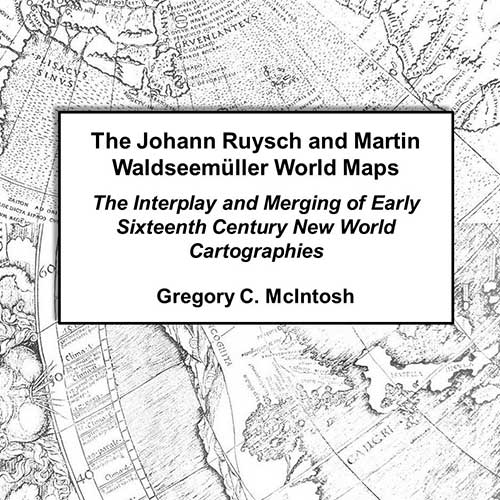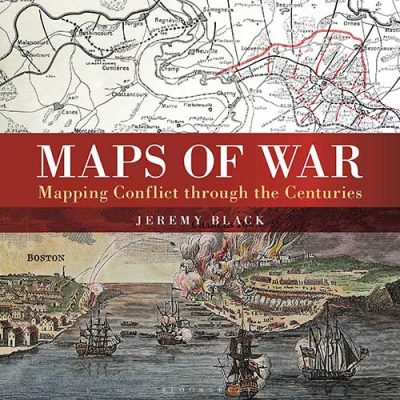This post contains Amazon Affiliate links for which I may receive compensation.
The full title of this book: The Johannes Ruysch and Martin Waldseemüller World Maps: The Interplay and Merging of Early Sixteenth Century New World Cartographies
This is a little book published by its author Gregory C. McIntosh who must have spent years of his life studying these world maps.
Could you imagine that we can see corrections on copper plates or wood blocks of early 16th-century maps and discover which changes were made from the time they were first printed to later printings?
That is one of the fascinating things you’ll discover in this book.
But the book is clearly addressed to scholars rather than to a general audience. It describes in extensive detail the differences in wording and shapes of landmasses between maps or even between several editions of the same map. On that topic, the last few pages include a long table detailing such information.
The objective of the author is to understand the chronology of the production of those maps, in which the mapmaker first described a certain region, or named a certain place. By analyzing every map with scrutiny and classifying them (the Lusitano-Germanic or King types in the present case) based on their similarities or differences, historians can conclude which other maps and which explorers’ journals the mapmakers of the time had access to when they drew and published their world maps of 1507, 1508 or 1516.

You may not care too much about the author’s theory that the first edition of the Ruysch world map was of a King-type but that its latter editions incorporated elements from Lusitano-Germanic type maps. Still, you may be interested to learn about the unusual life of Johann Ruysch, a Flemish monk born in Utrecht, who may have traveled to Newfoundland with John Cabot, lived in Germany and in Rome, where he painted the papal apartments with Raphael, and then went to Lisbon, where King Manuel made him an official. He then may have traveled to Africa, India, Brazil, and Newfoundland and died in 1533 in a monastery in Cologne, at the age of 75.
Personally, the most FASCINATING fact in this book was that you can still discern the corrections made to the original copper plates (Ruysch map) or wood blocks (Waldseemüller maps), from one edition to another, by carefully looking at the graphic representation of coastlines or sea waves or some typographic details.
There is no doubt that this world map is of major importance to the history of cartography. With its fan shape and polar projection, like the 1506 Contarini-Rosselli map it is modeled from, it depicts the world as two 180-degree parts ─ the Ptolemy old world and the New World. Published in 1508 it is one of the earliest printed world maps and it includes the recent European discoveries in the New World, Africa, and South Asia.
If you happen to read this book The Johannes Ruysch and Martin Waldseemüller World Maps: The Interplay and Merging of Early Sixteenth Century New World Cartographies (available on Amazon), make sure to share your opinion with us here!
Footnote: You may wonder what Lusitano-Germanic or King-type maps are. I am sure they teach about those in cartography classes, but finding definitions online is not easy.
The book offers such definitions. The characteristics of Lusitano-Germanic maps include:
- Greenland is a large triangular peninsula
- Newfoundland is a half-island unattached to any continent
- Hispaniola is called Espanola
- There is a large continental landmass to the west of Cuba
- South America has a continuous coastline from Venezuela to southern Brazil
- Some toponyms in South America are distinctive to this group of maps.
Maps in this group include the Cantino map (1502), the Caverio map (1503), the Waldseemüller maps of 1507 and 1516, and his “Tabula Terre Nove” 1513 map.
On the other hand, King-type New World map design ─ named after the King-Hamy 1502-1503 manuscript planisphere ─ is divided into three distinct regions and characterized by:
- Greenland is a narrow east-west island called “Terra Labrador”
- Newfoundland is a half-island due west of “Terra Labrador” and called “Terra Cortrealis”
- Some toponyms in the Caribbean are distinctive to this group of maps
- Cuba is smaller and thinner and called “Terra de Cuba”
- The coast of Brazil may be separate from the north coast of South America
Maps in this group include the 1504 Fano-Maggiolo map and the Kunstmann N°2 map (probably 1505).
I hope this clarifies.


